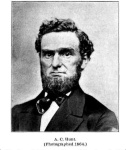With regard to the guidelines for the designation of Denver Historic Districts, applications must strongly qualify on two of three categories: History, Architecture, or Geography. A district must describes a definable sense of space with structures that relate or “contribute” to its period of significance. The “Historic” period must be over thirty years old, and have strong associations with specific persons or events in the “development of the city, state or nation.” A district may also qualify for “association with ethnic groups.” Districts require a survey of all structures within it. Individual structures or landmarks can be also designated. The lands comprising the La Alma Lincoln Park neighborhood can be said to represent two distinct periods of significance, although both can be tied together thematically by the “Spirit of the Worker.”
Governor Hunt’s Historic District
Most residences were built between 1870 and 1910, and were inhabited by a diverse collection of immigrants, here to work and to begin new lives in this young city. The development of the neighborhood really took off following the arrival of the Denver & Rio Grande RR shops at Burnham Yard in 1871. While Alexander Cameron Hunt was a huge part of developing that railroad in partnership with General Palmer, his civic service resume would suffice to apply. Hunt presided over the meeting that united Auraria and Denver in 1860, and helped bring order to the settlement as a judge of Denver’s early “Vigilance Committees.” He was appointed US Marshal by Lincoln and Fourth Territorial Governor by Johnson. He was known as a peacekeeper and friend to native residents, and also served as ”Ex-Officio Chief of Indian Affairs.” He was actually removed as governor by President Grant, who later apologized to Hunt with the gift of a prized horse, claiming that he had listened to lies from members of his famously corrupt cabinet. The home of A C Hunt was actually in the center of today’s La Alma Lincoln Park. The homestead was known as “Cloverside” for his successful experiments in growing alfalfa and determination to fill the land with trees he hauled down from his many mountain treks. Any dignitary of the day would have received an invitation to dine or drink at Hunt’s shady oasis. Determined to complete the vision of a railroad from Denver to Mexico City, and after the death of his wife and eldest son, Hunt had departed Denver forever by 1885, which marks the official opening of Lincoln Park.

A C Hunt’s “Cloverside”From Cannon, Helen, First ladies of Colorado–Ellen Kellogg Hunt, Denver (Colo.): State Historical Society of Colorado, 1962. Courtesy History Colorado Call Number: SER Colorado Magazine Vol. 39, no. 2 (pp. 125-132)
Old maps show Hunt’s Addition cover the largest part of the neighborhood, as a rectangle section from Colfax and Santa Fe southwest to Sixth Ave and Osage at the Denver Rio Grande tracks. A fair amount of the original housing (contributing architecture) exists between Kalamath and Mariposa, but the boundaries of the district could be formed around various other practical considerations. Subdivisions within the neighborhood, such as Smith and Elmwood may offer more district opportunities, but are not as fully researched yet.
Santa Fe Historic Cultural District

Centro Cultural festival and grand opening at 935 W 11th Ave, DPL Western History Collection X-21619
Postwar America saw drastic changes to the fabric of cities as the middle class fled to the suburbs. “La Alma” represents a period of significance (60’s to 80’s or 90’s? Need clarity on 30 year rule) when the Latino population swelled to over 90% of neighborhood residences, and Santa Fe became “ground zero” for the Chicano Movement in Denver. It is a story of self-empowerment, civil rights, and cultural pride. “La Alma” literally means “soul,” but in connection with hero Cesar Chavez, represents the “Spirit of the Worker.”
Since there are few obvious architectural landmarks that stand out as significant to the La Alma period, and there has been very little documentation of the history so far, this application has needed to take a less traditional, more creative approach. As an old commercial corridor and entry to the city, a strong case can be offered on geography, which helps make Santa Fe a great place to focus this district. Writing the application to describe the “Cultural History” and significance is much less developed so far, with many more collaborators needed. Video interviews in the works already.
The newly rebranded Welton corridor is instructive and the 5 Points Historic Cultural District provides a useful template to help frame a similar district here. They identified 20 historic locations that are incorporated into a walking tour. See http://www.fivepointsbiz.org/historic-walking-tour for more info.
Finding “buildings that reflect the ethnic heritage” seem to be the biggest challenge. Potential landmarks on Santa Fe significant to La Alma period: Museo de las Américas, Su Teatro/Denver Civic Theater, Byers Library, Aztlan Theater, Hispanic Heritage Center, CHAC Gallery, Tortillas de M, El Noa Noa,Tacos de M .
More info on events and prior uses is needed to expand and refine list.
If you wonder ”why we need a historic district?”- try Historic Denver’s FAQ at http://www.historicdenver.org/resources/landmark-designation-FAQs/ but in short,
Districts typically stabilize or increase property values, and can stimulate economic development. Though exterior changes are subject to City review, denials of permits are very rare and simply intend to “preserve of the historic character” of a district, offering us all some protection. Property owners within a district are also eligible to receive State tax credits for improvements.

